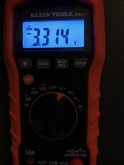NCblueridge
New Member
- Joined
- Jul 31, 2020
- Messages
- 154
Hi everyone. So I have mmy new 4 Lifpo batteries connected in parallel and recieved the inexpensive power supply I bought on Amazon.
The out of the box voltages for the 4 105AH cells were originally:
3.298
3.288
3.248
3.184
After spending some time understanding this new Dr. Meter variable bench power supply (30volt/10amp), I locked the voltage in at 3.65 CV. I then connected my terminals to the respective positive/negatives on the batteries and set the amps as high as they will go.
Voltage is remaining constant but amperage seems to be really low (@3 amps max) and obviously wattage at @12 or less.
I also have my multimeter hooked up and have been checking the values since. It is slowly rising but it seems like it could take days or more before the pack gets to the desired voltage.
2:00pm, 3.297
4:30pm,3.311
9:23p, 3.314
Here's a few pics of the PS and my multimeter attached and my mm I just took.
The PS working:

The current voltage of the bank:

Is this normal for a situation like this - the PS is supposed to go to 10 AMPS but it hasn't moved past @3 amps after hours?
Thanks,
William
The out of the box voltages for the 4 105AH cells were originally:
3.298
3.288
3.248
3.184
After spending some time understanding this new Dr. Meter variable bench power supply (30volt/10amp), I locked the voltage in at 3.65 CV. I then connected my terminals to the respective positive/negatives on the batteries and set the amps as high as they will go.
Voltage is remaining constant but amperage seems to be really low (@3 amps max) and obviously wattage at @12 or less.
I also have my multimeter hooked up and have been checking the values since. It is slowly rising but it seems like it could take days or more before the pack gets to the desired voltage.
2:00pm, 3.297
4:30pm,3.311
9:23p, 3.314
Here's a few pics of the PS and my multimeter attached and my mm I just took.
The PS working:

The current voltage of the bank:

Is this normal for a situation like this - the PS is supposed to go to 10 AMPS but it hasn't moved past @3 amps after hours?
Thanks,
William







